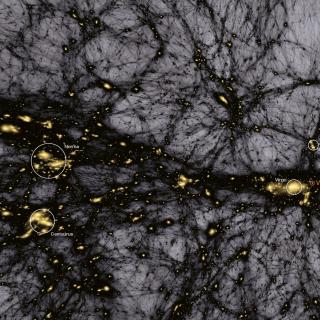Bibcode
Angulo, Raul E.; Sodré, Laerte; Dupke, Renato; Ederoclite, Alessandro; Alcaniz, Jailson; Vázquez Ramió, Héctor; Varela, Jesús; Moles, Mariano; Marín-Franch, Antonio; López-Sanjuan, Carlos; Hernández-Monteagudo, Carlos; Cenarro, Javier; Cristóbal-Hornillos, David; Daflon, Simone; Jiménez-Esteban, Fran; Cruz, Patricia; Galindo-Guil, F. J.; Coelho, Paula; Fan, Zhou; Liu, Jifeng; Hong, Jihye; Gu, Hongrui; Lee, Young Sun; Yuan, Haibo; Xiao, Kai; Beers, Timothy C.; Huang, Yang
Bibliographical reference
The Astrophysical Journal
Advertised on:
10
2024
Journal
Citations
9
Refereed citations
6
Description
We present a catalog of stellar parameters (effective temperature T eff, surface gravity , age, and metallicity [Fe/H]) and elemental-abundance ratios ([C/Fe], [Mg/Fe], and [α/Fe]) for some five million stars (4.5 million dwarfs and 0.5 million giant stars) in the Milky Way, based on stellar colors from the Javalambre Photometric Local Universe Survey (J-PLUS) DR3 and Gaia EDR3. These estimates are obtained through the construction of a large spectroscopic training set with parameters and abundances adjusted to uniform scales, and trained with a kernel principal component analysis. Owing to the seven narrow/medium-band filters employed by J-PLUS, we obtain precisions in the abundance estimates that are as good as or better than those derived from medium-resolution spectroscopy for stars covering a wide range of the parameter space: 0.10–0.20 dex for [Fe/H] and [C/Fe], and 0.05 dex for [Mg/Fe] and [α/Fe]. Moreover, systematic errors due to the influence of molecular carbon bands on previous photometric-metallicity estimates (which only included two narrow/medium-band blue filters) have now been removed, resulting in photometric-metallicity estimates down to [Fe/H] ∼ ‑4.0, with typical uncertainties of 0.40 dex and 0.25 dex for dwarfs and giants, respectively. This large photometric sample should prove useful for the exploration of the assembly and chemical-evolution history of our Galaxy.
Related projects

Cosmology with Large Scale Structure Probes
The Cosmic Microwave Background (CMB) contains the statistical information about the early seeds of the structure formation in our Universe. Its natural counterpart in the local universe is the distribution of galaxies that arises as a result of gravitational growth of those primordial and small density fluctuations. The characterization of the
FRANCISCO SHU
KITAURA JOYANES